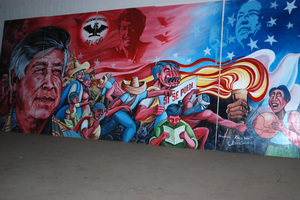By Anna Consie
Cronkite News Service
PHOENIX – Pointing to a small room now filled with boxes and dust, Alfredo Gutierrez joked about the day César Chávez appropriated his office.

It was 1972, and Chavez had picked the Santa Rita Center, where Gutierrez worked as a community organizer, as the scene of his fast protesting an Arizona law limiting the rights of farmworkers.
“It was my office, but he decided that’s where he wanted to be, so I left the office. What a jerk,” he said, laughing.
During Chávez’s 24-day fast, the Santa Rita Center, in a neighborhood near downtown where many farmworkers lived, became a mecca for Chicano activism, said Gutierrez, who later served as minority leader in the Arizona State Senate.
Hundreds gathered for nightly masses and inspirational meetings at noon, he said.
“César participated (in the gatherings) for perhaps 10 days or so, but thereafter he wasn’t strong enough,” Gutierrez said.
Out of that protest came Chávez’s rallying cry “Si se puede,” Spanish for “Yes we can.”
Now, nearly 40 years later, the Santa Rita Center is listed among sites that could receive national historic recognition based on their connection to Chávez and the United Farm Workers movement he helped found. There are seven other sites around Arizona, including the ruins of Chávez’s birthplace in Yuma.
Under legislation passed by Congress in 2008, the National Park Service is reviewing sites in Arizona and California. Its recommendations will go back to Congress later this year, said Martha Crusius, the National Park Service project manager.
The legislation aims to ensure that Chávez’s legacy stays alive and sites significant to his life and work gain the recognition they deserve, she said.
Other Arizona locations on the list include a small home in San Luis where Chávez died in 1993 and the former Del Webb Towne House, now a Hilton Garden Inn in uptown Phoenix, where Chávez ended his 1972 fast at an event attended by thousands, including singer Joan Baez.
Raymond Rast, a research partner for the study and assistant director for oral and public history at California State University, Fullerton, said Arizona is intertwined with Chávez’s life.
“He was taught to maintain his dignity and nonviolence there, and he carried those values through the rest of his life,” Rast said.
In spring 1972, Chávez returned to Arizona to protest a law that prohibited farm workers from picketing. He organized a voter registration drive to recall then-Gov. Jack Williams, an effort that centered around what he called his “fast for love.”
That led him to the Santa Rita Center, built by parishioners of nearby Sacred Heart Church.
“When he was shown this place, which sat in the middle of an impoverished barrio where a lot of farmworkers were living at the time, he said, ‘This is the place I want to fast,'” said Jose Cortez, a community activist and former labor organizer for Chávez.
Preserving those stories and Chávez’s legacy is a passion for Cortez. Inspired by his work for Chávez, he began to clean and restore the center in 2000. In 2004, Chicanos por la Causa purchased the building to preserve the center and its history.
In 2007, the Santa Rita Center was listed on the Phoenix Historic Property Register.
Rast said the center’s significance and condition give it a good chance of gaining national recognition.
“The Santa Rita Center really has a strong, significant history for the nation and the state,” he said.
The four other sites in Arizona are: a Yuma building that once housed Laguna School, which Chávez attended for seven years; the crumbling remains of his childhood home just outside Yuma; a United Farm Workers field office in San Luis; and a Tolleson house that once served as the United Farm Workers Organizing Committee’s Arizona headquarters.
Options for the sites approved by Congress include being admitted to the National Park System, being recognized as National Historic Landmarks or addition to the National Register of Historic Places.
For its caretakers, the fact that the Santa Rita Center is being considered is an honor, Cortez said.
“This building has always been the beacon of this community,” he said. “It holds a lot of energy. It’s a very spiritual place. Every time I come in here I feel so energized. I feel like I’m ready to tackle any issue that you throw at me.”
Arizona sites:
– Santa Rita Center, Phoenix
– Del Webb Towne House, Phoenix
– former United Farm Workers Organizing Committee’s Arizona headquarters, Tolleson
– Chavez family homestead, Yuma
– Chavez family general store, Yuma
– Laguna School, Yuma
– United Farm Workers field office, San Luis
– Dona Maria Hau House, San Luis




